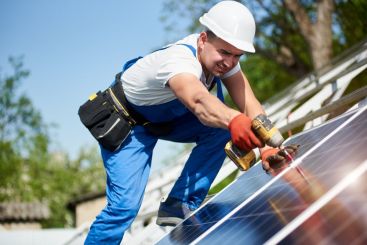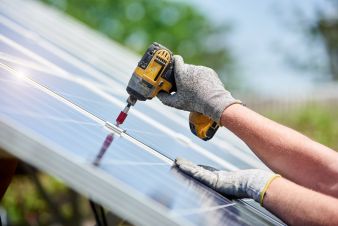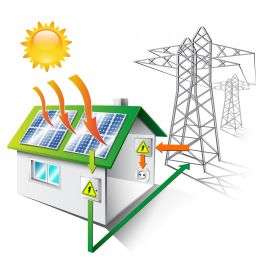Solar Panel & Roof: Types of Solar Panels for Roofs New Jersey
Solar panels for roof
Solar panels come in many different types. Not all solar panels are made from the same materials, nor do they work the same way. By learning about the differences between various types of solar panels for roofs, you can make a more well-informed decision on what type of solar panel will work best for your house or business.
What kinds of solar panels are available on the market?
The 3 types of solar panels are monocrystalline, polycrystalline, and thin film. Monocrystalline is made up of a single crystal, polycrystalline is made up of several crystals and thin film panels are more flexible than other types.
Monocrystalline solar panels (mono-cells)
Monocrystalline solar panels (also called mono-cells) are made from a single cell cut from wafers, much like how an ingot is cut from large metal blocks. All the cells in monocrystalline solar panels contain the same amount and type of semiconductor material (usually silicon) and are all cut from the same ingot. This allows monocrystalline solar panels to produce more energy than other solar panels but at a higher cost.

Polycrystalline solar panels (poly-cells)
This type of solar panel is less expensive than monocrystalline but still more costly than thin-film photovoltaic (PV) panels. The cells of polycrystalline solar panels are thicker than those of monocrystalline solar modules, so they don’t absorb as much light and generate less energy.
Thin-film solar panels
Thin-film photovoltaic panels are made from a thin layer of amorphous silicon, cadmium telluride, or copper indium gallium selenide. The silicon in a thin-film panel is much less pure than what you’d find in a conventional solar cell because the purity of the material isn’t as important. The cells are combined to make thin-film solar panels more affordable, but they are less efficient than standard solar panels. Thin-film panels are most notable for their ease of installation compared to conventional panels.
- Cadmium telluride (CdTe)
CdTe cells have the lowest cost of any solar panel, as well as the lowest carbon footprint, water use, and energy payback time. The cells in CdTe panels are one-fourth the size of conventional solar cells which means there’s less material that needs recycling when it’s time to replace them.
- Amorphous silicon (a-Si)
Amorphous silicon (a-Si) solar panels are less efficient than conventional PV solar cells, but they’re still a better option than fossil fuels. They’re relatively inexpensive to produce and easy to install.
- Copper indium gallium selenide (CIGS)
CIGS solar panels are similar to monocrystalline panels, but they’re more flexible and can be curved. They produce the most energy of any thin-film PV solar cells on the market today, but their production costs are still ten times higher than conventional panels.
Passivated Emitter and Rear Cell (PERC) panels
These are the latest innovation in solar panels. Traditional solar panels are made up of one large wafer with 36-38 cells, but PERC solar cells are much smaller than the traditional ones and come together to make a larger panel.
Each cell is also passivated on both sides for added safety. It also produces a little more voltage and power output, allowing the panels to have more energy even when there’s high heat or shade.
Solar panels according to their efficiency
Many roof types solar PV panels are available today, but most have one thing in common: They all convert the sun’s energy into electricity. That is to say; they produce a direct current (DC) electricity from sunlight. The effectiveness of each panel type depends on how the cell is constructed and its size, and efficiency varies considerably. The quantity of amps, watts, and volts in a cell is known as the capacity. A solar panel’s watt rating is how many watts of DC power it can produce at peak performance. As you’ll see below, the maximum number varies for each type of solar panel.
The efficiency of solar cells
The most common type of photovoltaic cell, made from silicon crystals, is about 20% efficient at converting sunlight to electricity. That means the cells can convert about 150 watts of solar energy per square meter (one square foot) under optimal conditions.

- Monocrystalline solar panels are about 15%-20% efficient, which is a bit better than polycrystalline panels
- Polycrystalline solar panels are about 13-16% efficient, which is lower than monocrystalline panels.
- Passivated Emitter and Rear Cell (PERC) panels are up to 22% efficient.
- Thin-film solar panels are much less efficient, with amorphous silicon (a-Si) panels being about 6-7% efficient.
Solar panel systems based on experience and quality
Inverter Type Solar Panel
Inverter-type panels are one of the best choices for those who want to ensure that their panel will produce as much power as it can. These solar panels come standard with microinverters on each cell, which means no central inverter is involved in this process. Instead, each inverter is directly wired to multiple cells in the panel, which allows for much more efficient power conversion. Solar inverters come with a guarantee that they will produce a certain amount of voltage and current at a specific time under ideal conditions.

Grid-Tied
This type of solar panel comes with an inverter tied into your area’s electrical grid, which allows you to feed electricity back into your home’s grid when necessary. Although this type of solar panel is far less expensive than off-grid or stand-alone panels, it has some significant downsides, including concerns about how quickly the inverter can react to blackouts and other power disruptions.
Off-Grid/Stand-Alone
The main advantage of off-grid panels is that they do not require a connection to your home’s electrical grid to function correctly. However, they do allow you to produce electrical power in the event of a blackout, and their energy supply is entirely independent of your home’s electrical grid. Off-grid panels also have a much higher initial cost than other types of solar panels.
What is the cost of different solar panel types?
A typical 250-watt panel might cost anything from $175 to $375. The average total cost of a monocrystalline system ranges from $1 to $1.50 per watt, depending on the size of the array and the number of modules used. Polycrystalline solar panels range in price from $0.90 to $1 per watt. On average, thin-film solar panels cost between $1 and $1.50 per watt, meaning that outfitting a 6kW solar panel system costs between $6,000 and $9,000.
The cost of solar panels also depends on three factors: the solar panel types, its quality rating, and the size.
Type of panel
Depending on the purpose for which you want to utilize it, you may save money by selecting a specific panel type. For instance, thin-film panels are lightweight and flexible, which makes them the perfect choice for the top of a commercial building. Monocrystalline silicon panels are also very efficient; however, they tend to be more expensive than other types. Polycrystalline silicon is a practical compromise between efficiency and cost.
Quality rating
The best way to tell whether a panel is of high quality is to look at the panel’s wattage. The quality rating is essentially a measure of how much power it can produce, so higher wattage panels are more efficient.
However, there is also a correlation between wattage and price. If you’re concerned about the cost of your panels, try to look for high-quality panels with high wattage that is within your budget.
Size
The size of the panel you purchase will determine how much power it can produce. The most common sizes are usually between eight and ten feet.
Overall, solar panels cost depends on the type of panel, its quality rating, and size. Solar panels can save you money in the long run because they produce free electricity once installed. However, it’s important to remember that even though purchasing high-quality panels will save more energy; their price will be higher.
Which are the best types of solar PV panels to choose?
No single type of solar panel is best, but some types are better suited to particular applications.
Monocrystalline solar panels
One of the most common types of solar cells is monocrystalline. These types of solar panels have aluminum frames. They tend to be sturdier than any other type of solar cell panel. However, the aluminum in the frame reduces the light that hits the cell, so it’s difficult to compare the solar capacity of monocrystalline panels with any other type. Solar system designers often consider this and increase the number of cells required for power output when using solar panels monocrystalline.
Polycrystalline solar panels

Solar panels polycrystalline is another common type of solar cell. These are often more affordable than monocrystalline panels but are not as efficient. Polycrystalline solar cells contain several different-sized crystals, and it’s challenging to get the perfect size for optimal electric conversion. This limits the overall efficiency of the panel compared to monocrystalline panels.
Passivated Emitter and Rear Cell (PERC) panels
PERC cells have a single junction but have added layers that increase the electric charge inside the cell. This makes them more efficient at converting sunlight into electricity than standard silicon solar panels. Often, these types of solar panels are manufactured using monocrystalline silicon.
Thin Film Solar Panels
These are created from thin layers of photovoltaic material. The most common is amorphous silicon, which has the same chemical structure as monocrystalline silicon but without any long-range order.
The main advantage of thin film solar PV panels is that they are incredibly flexible and can be used on a wide range of surfaces. They also tend to be less efficient than other types of solar panels but can be more affordable.
What is a solar roof shingle?
Solar roofing, like solar panels, is a way to convert the sun’s energy that shines on your roof into an available power source for your house. There are several different types of solar roofing systems on the market, but they’re all essentially tiny solar panels disguised to appear like and perform as real roofing materials.
The major market force propelling solar roofs solutions has been consumer demand for solar panels that are less obvious and noticeable. Some people appreciate the “futuristic” appearance of a roof covered in solar panels, while others regret the loss of a classic roofing style. Solar panel shingles and slate tiles are made to appear like asphalt shingles or tile roofs while generating electricity. Building-integrated photovoltaics (BIPV) are the various types of solar roofing.
Tesla Energy is the company behind the solar roofing system. Solar roofs Tesla are made with tempered glass for strength and durability.
What are the basic roofing requirements for installing solar panels?
When installing solar panels on a roof, it is important to consider the basic requirements for the solar project to be successful. Some of these include:
• Roofing Material: Roofs made of asphalt or wood shingles are not considered suitable for facilitating solar panel installation, while metal roofs are more appropriate.
• Roof Pitch: The roof should have a relatively low pitch of around 5° or less. A more important consideration for this is the slope of the panel itself. If the panel is anchored too steeply, it can reduce its performance by up to 20%. Some panels are mounted at an angle to make up for uneven surfaces while others can be custom-raked to avoid problems.
• Clearance from Walls: When installing panels on slanted roofs, it is important that they are not blocked by walls or other structures. This can reduce the solar panel’s performance by as much as 40%.
• Shade: Even a small amount of shade cast on a solar panel (if it is exposed to daily sunlight) can reduce its output. Trees and other elements growing close to the roof should be monitored for growth, and removed if necessary.
• Roof Age: Solar panels are not designed for use on roofs older than 15 years. Beyond this point, the roof has likely deteriorated significantly. Warranty for solar panel installation may be voided if the roof is too old.
Frequently Asked Questions
What type of panel is best for your solar panel installation?
It’s impossible to tell you which solar panel type is “best” for your solar panel installation. However, if you are thinking about installing a new system, it’s worth considering the different types available and their relative benefits. If existing solar panels need replacing or additional panels are required, the choice will come down to what works best besides other considerations such as cost, space available, and aesthetics.
What type of panels is most prevalent?
Monocrystalline and PERC panels are the two most popular types of solar panels.
Monocrystalline solar panels have the highest efficiency, but they’re also more expensive than other options. However, their high levels of efficiency mean that they tend to produce more electricity over time than any other type of panel.
PERC panels have the second-highest efficiency, but they tend to be more affordable than monocrystalline solar panels. However, their relatively low efficiencies mean that you’ll need a more significant number of PERC panels to produce the same amount of power as monocrystalline solar panels.
What does it mean by the amorphous thin film solar?
Amorphous solar panels are made from an advanced silicon material that is free of crystals. This means the photovoltaic cells have different sizes, shapes, and textures than traditional crystalline solar cells. They look more like a large sheet of plastic rather than a conventional solar panel.
Can you put an amorphous silicon solar panel on your roof?
This is possible but not recommended. Amorphous solar panels do not have the same durability as crystalline solar panels, so they are best kept to commercial applications to be handled more carefully. They are also less efficient than crystalline solar panels, which means less energy production, making them unsuitable for residential applications.
How do I decide which type of solar system to use?
The best solar system for your needs is the one you can afford. The most important thing is that it covers 100 percent of your energy requirements efficiently with no additional costs for maintenance.
The type of solar panels you choose should be based on your budget, location, and shade tolerance of each specific type. The type of solar panels you choose should be based on your budget, location, and shade tolerance of each specific type. Solar financing options such as federal tax credit and solar loans may fit your bill. Federal tax credits are available for up to 26 percent of the cost of a solar system, and many states also offer their own incentives. Solar loans are a good option if you don’t have the cash to pay for a solar system upfront.
Why are some types of solar PV panels better than others?
There are many different types of solar panels on the market today. There are several key differences between them, but they all work according to the same underlying principles. Most have aluminum frames, which require less manufacturing energy to create, making them more environmentally friendly. Solar panels work when electrons move from a negatively charged solar cell to a positively charged one. When there is no movement of the charge, no energy is generated.
How reliable are solar panels for generating electricity?
Since the invention of the solar panel, they have been highly reliable. The silicon material has a very long life expectancy which means they are unlikely to fail. This technology has also been around for several decades, so it is well-tested, and you can be sure it will function as expected almost all of the time.
Why solar roof shingles instead of solar panels?
With solar roof shingles, you get all the benefits of a traditional roof combined with the satisfaction that comes from generating your own electricity. Traditional solar panels are an eyesore for most people, but solar shingles blend in because they look like ordinary asphalt shingles. When it’s time for a new roof installation or roof replacement, homeowners might seriously consider opting for shingle solar roofing instead of traditional solar panels. Solar roof Tesla, which makes solar roof tiles, explains that its Tesla solar roof tiles are unlike traditional solar panels.
